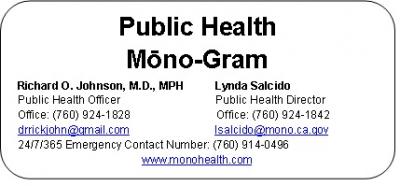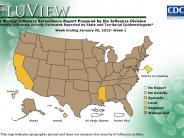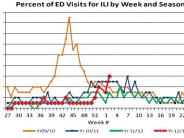Mono-Gram: Time to Get Serious-Influenza 1/16/2013
Wednesday, January 16, 2013
Time to Get Serious
Influenza is hitting the nation harder than it did at this point last year, and it could be peaking in some parts of the country, but it has not yet reached its peak in California.
Persons who have not yet gotten vaccinated against seasonal influenza should do so, and sooner rather than later. In addition to just beating the anticipated peak, the supply is barely keeping up with the increased demand. Influenza vaccine makers were expected to supply the US market with some 135 million doses. As of January 4, roughly 128 million doses had been distributed. Given reports of spot shortages, vaccine seekers may have to call more than a single healthcare provider to receive their dose. Try your healthcare provider, a pharmacy, or the health department.
The effectiveness of the current seasonal influenza vaccine is 62%, which means that 38% of us who get vaccinated could still contract influenza. These are still good odds, with this vaccine being a perfect match for circulating strains of the flu virus. The flu vaccine is far from perfect, but it is the best tool by far for preventing the flu. It is well worth the effort, and decades of experience show that it is very safe.
Fear of "Bad Year" Becoming a Reality
In early December 2012, the CDC said that given the early onset of the 2012-2013 influenza season and the particular mix of viruses in circulation, this could be a bad year. The ensuing weeks have proved them right. Patients presenting with influenza-like illness (ILI) have flooded hospital emergency departments in the Northeast, for example — so much so that public health emergencies have been declared in Boston, New York State, and Indiana.
The CDC's latest weekly surveillance report of influenza activity, covering the first week of 2013 and ending January 5, continues to support the "bad year" outlook. According to the report, 47 states reported widespread geographic influenza activity, which is 6 more than the week before. In comparison, no state reported widespread geographic influenza activity for the first week of 2012. 20 children have died so far in this influenza season. Although California is one of the 3 states only reporting regional activity, emergency department visits in San Diego for influenza-like illness have doubled in the last reporting week, evidence that things are beginning to happen in Southern California. We all recognize that whatever happens in Southern California, happens in Mammoth within a few weeks. We are seeing signs that the flu has reached Mono County, and is expected to continue to increase over the next few weeks.
The CDC also said the ILI trend suggests that influenza is peaking or waning in some states. However, the findings for the last week of 2012 preclude certainty because they can represent an artificial holiday spike. Americans make fewer trips to physician offices in December for routine matters such as check-ups, so the patients who do end up in the waiting room "have a different pattern of illness." As a result, the ILI rate can swell up. It will take a few more weeks of influenza surveillance and more data points to confirm the trend.
Predominant A(H3N2) Virus Associated With More Severe Flu Season
Of the influenza viruses in circulation as of January 5, the most common is A(H3N2). Influenza seasons tend to be more severe when this virus predominates. The United States has not experienced a major A(H3N2) outbreak since the 2007-2008 season. This may explain why this year's spread is so extensive. The once dreaded pandemic influenza A(H1N1) virus from 2009, and a Type B virus, are both circulating in small numbers. All 3 of the circulating types are included in this year’s vaccine.
Predicting when, where, and how bad a flu season will become is about like predicting earthquakes. We know that influenza viruses in a given country, city, or region will vary from year to year in unpredictable ways. We just do not know why. Stay tuned, and follow the tips on the next page!
Flu Season is Here--Take Action Now
Do your part to protect yourself and others against the flu.
If you have the flu,
• Stay home
• Follow your health care provider’s recommendations
• Prevent the spread of the flu with these flu-fighting tips.
If you don’t have the flu, it’s not too late to get a flu shot! The best protection against the flu is to get the vaccine. Seasonal flu vaccines have a very good safety record.
Everyone 6 months of age and older should get vaccinated. It is especially important to get the vaccine if you, or someone you live with or care for is at high risk of complications from the flu. Our flu infographic shows you what you need to know about the flu vaccine.
- Video: What is the best protection against the flu?
- Video: How can I prevent the spread of the flu?
Everybody can do their part to help prevent the spread of germs and protect themselves from the flu. For the latest information about this flu season.
National Flu Situation homepage:
http://www.vuetoo.com/vue1/SituationPageNews.asp?sit=8188&ref=anm




